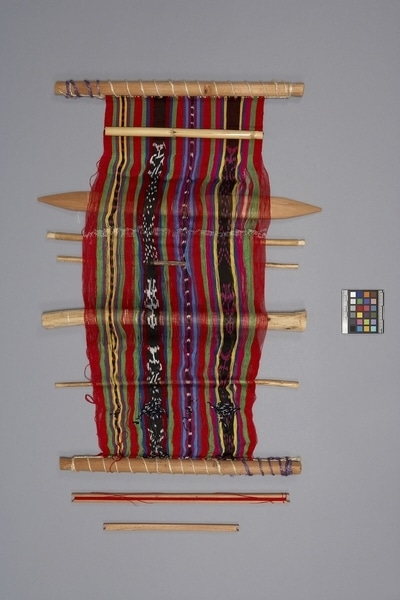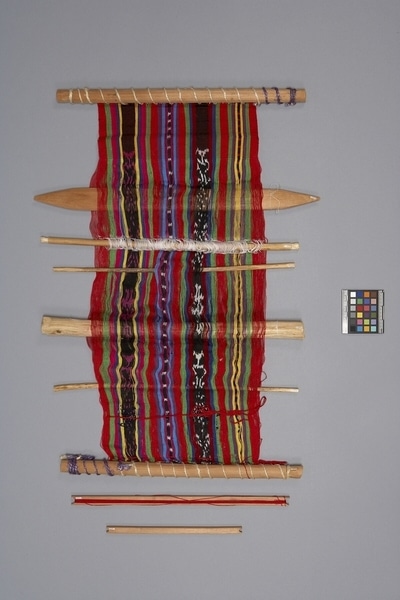Loom Item Number: Sa200 a-h from the MOA: University of British Columbia


Description
Back strap loom (parts a-h) with associated pieces. An unfinished textile is stretched between loom end sticks (part a). The weaving has been started at the top of the loom. Loom is warped with multi-coloured stripes of solid and resist-dyed cotton ikat (jaspe). Detailed are black, yellow, green, blue, purple and white stripes on a red ground. Intertwined in the warp is a flat, rectangular batten with triangular, pointed ends (part b); a cylindrical shaped heddle covered in white twine (part c); two rectangular sticks of wood with semi-circular indentations (parts e and f); a shed role (part g) and two thin wooden sticks (parts d and h).
History Of Use
Back strap looms are used by women to weave panels to made huipils, tzutes, pants and shirts, wide fajas, and other bands.
Cultural Context
weaving
Narrative
This is a demonstration loom made by a woman in San Jorge for a weaving class. This sample is not wide enough to be used in garment manufacture (Lambert).
Specific Techniques
This loom has one set of string heddles. String heading gives textiles a selvedge edge at the top of the fabric.
Item History
What
- Name
- Loom
- Identification Number
- Sa200 a-h
- Type of Item
- loom
- Material
- wood, cotton fibre, metal, fibre and dye
- Manufacturing Technique
- tied, woven, nailed, dyed and carved
- Part B
- height 53.1 cm, width 4.2 cm, depth 1.0 cm
- Part A
- height 72.3 cm, width 45.2 cm
- Part C
- height 48.1 cm, diameter 1.0 cm
- Part D
- height 45.2 cm, diameter 0.7 cm
- Part E
- height 40.6 cm, width 1.6 cm, depth 1.0 cm
- Part F
- height 25.2 cm, width 1.1 cm, depth 0.8 cm
- Part G
- height 48.4 cm, diameter 3.6 cm
- Part H
- height 45.7 cm, diameter 1.2 cm
Who
- Culture
- Cakchiquel
- Previous Owner
- Inge Ruus
- Received from
- Inge Ruus (Donor)
Where
- Holding Institution
- MOA: University of British Columbia
- Made in
- San Jorge, Solola, Guatemala
When
- Creation Date
- before 1976
- Collection Date
- during 1976
- Ownership Date
- before August 11, 1976
- Acquisition Date
- on August 11, 1976
Other
- Item Classes
- textiles
- Condition
- good
- Accession Number
- 0319/0002 a-h